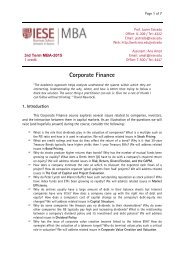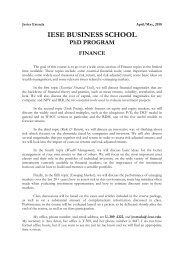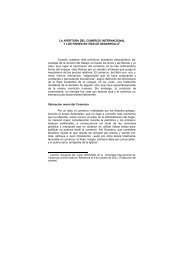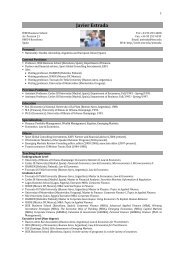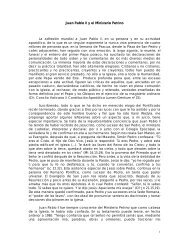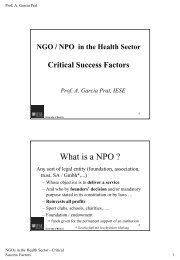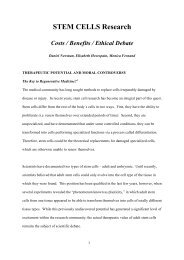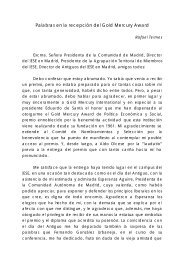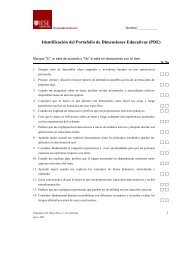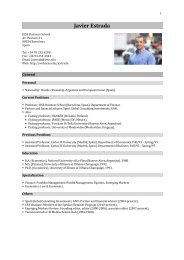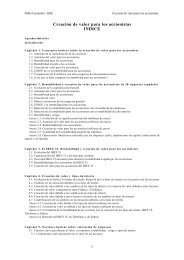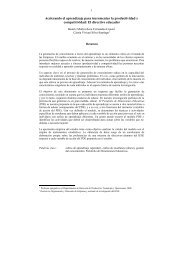GPOs and Advances Purchasing Mechanism - IESE Blog Community
GPOs and Advances Purchasing Mechanism - IESE Blog Community
GPOs and Advances Purchasing Mechanism - IESE Blog Community
You also want an ePaper? Increase the reach of your titles
YUMPU automatically turns print PDFs into web optimized ePapers that Google loves.
y the Catalonian Health Service, which carries out assessment surveys for hospitals,<br />
health insurers <strong>and</strong> the medical industry.<br />
In the mid-nineties, there was a revolution in the way hospitals manage their purchases.<br />
We saw innovation in logistics, greater education, centralized catalogues, group<br />
purchasing. The first model of advanced purchasing, unique supplier of several products,<br />
was implemented by Hospital Reina Sofía de Córdoba. The unique catalogue model was<br />
applied by the ICS since 1994 (also by Servei Valencia de Salut <strong>and</strong> Servicio<br />
Extremeño de Salud).<br />
Nowadays, we have to differentiate those regions which have been managing their<br />
competencies for a long time from those that have just started in 2002. Obviously, we<br />
find that the former regions have much more advanced models of group purchasing<br />
organizations. Here, there should be incentives in place to share experiences <strong>and</strong><br />
information from one region to another. In all, there will be 17 separate purchasing<br />
systems.<br />
The typical purchasing model today is to have a unique catalogue for the needs of<br />
health-care providers of a region. A tender by product type is then organized on a yearly<br />
basis. This is the case for many regions such as Cataluña, Comunidad Valenciana <strong>and</strong><br />
Andalucía.<br />
In the future, we could envisage a system where regions share their catalogues, so that<br />
one region with a dominant position in one product line could translate the benefits to<br />
other regions. Alternatively, when a hospital needs a certain product, they call the<br />
supplier that won the tender for that product <strong>and</strong> ask for the product delivery. This<br />
process could be centralized in the future saving some transaction costs. This model<br />
could make sense for small hospitals because of their lack of scale.<br />
Example 1 of GPO: Banco de Productos del SAS<br />
The Servicio Andaluz de Salud (SAS) is the public organisation for the Andalucia<br />
region responsible for providing health-care services to citizens from the region.<br />
The SAS has recently centralized all the purchasing process of products <strong>and</strong> materials<br />
from public health-care institutions. Basically, the products <strong>and</strong> materials that can be<br />
used by hospitals must first be screened <strong>and</strong> registered into a centralized database. Then,<br />
the SAS opens public tenders to secure the supply of specific products or materials.<br />
Once the public tender has been allocated to a supplier, the payment, stocking <strong>and</strong><br />
distribution of the products are managed on a centralized basis.<br />
This group purchasing initiative seeks reducing purchasing costs for products <strong>and</strong><br />
materials, as well as improving efficiencies in supply <strong>and</strong> logistics management.<br />
Example 2 of GPO: Saniline<br />
Saniline is the leading company in Spain offering services of supply chain management<br />
activities for health-care providers <strong>and</strong> suppliers through its Internet platform. Saniline<br />
believes that connecting clients <strong>and</strong> suppliers through the Internet is a powerful<br />
efficiency driver of supply chain processes as well as a cost reduction tool.<br />
-8-



